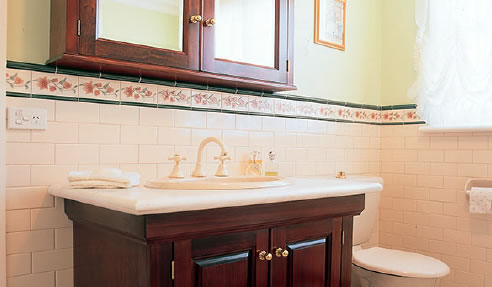Installing Edwardian Tiles from Designer Ceramics

Edwardian Tiles: How To Install Like An Expert
Edwardian tiles are an example of the ingenuity of the Edwardian Era - the time in history where the Industrial Revolution changed human civilisation. The growth of industry in manufacturing plus mechanical and technological innovations led to profound creativity and design in both arts and crafts.
The Garland design from the Edwardian tiles collection by Designer Ceramics exudes some of the Edwardian elements of femininity - accentuated by light colour and a floral design. Garland Edwardian tiles have an embossed, glossy intricate floral pattern bordered with a twisting cord design. The use of Edwardian wall tiles is an ideal makeover solution for consumers who want to experience the luxury of Edwardian Era.
Designer Ceramics' Edwardian wall tiles are chosen by architects and interior designers for restoration work and to enhance a property with classic architectural styling. For do-it-yourself buffs, Designer Ceramics have laid down the basics of installing Edwardian tiles like an expert.
Note: Designer Ceramics' Edwardian wall tiles come in a standard size of 8 inches or 198mm.
Part 1: Preparing the Wall
1. Ensure that the wall is prepped and good to go. After the old wall dressings and wall items have been removed, like light switch covers, check if the base layer which is the building block is still fit and sound. This is an essential part of installing ceramic tiles, whether done by professionals or by an amateur.

a. Check for signs of mould or tile surface damage. Change the damaged surface if necessary to ensure a prolonged life for the new ceramic tiles.
b. A soft wall or studs may require additional work.
c. For a bigger tiling project, it is best advised to use a tiling board as a backer wall rather than just directly applying the ceramic tiles to the wall. A tiling board is installed by nailing it to the stud. It is water resistant which is great to use in the bathroom and kitchen since it will not rot and warp.
2. Measure and mark the middle lines where the tiling will occur using a level and measuring tape.
3. Mark the measured locations with a chalk snap line.
4. Dry fit the tiles to ensure that the desired look will be achieved. Dry fitting is important especially if the ceramic tile makes up a pattern. This also helps to avoid making any mistake.
5. Using a batten (a long and flat strip of squared wood or metal that is used to hold something in place or as a fastening against a wall) helps keep the tiles arranged in a straight row.
Part 2: Laying the Tiles
- Mixing the mortar following the manufacturer's instructions. The rule of thumb, however, is to start by slowly adding the water in the bucket where the powder is until the mixture has the same consistency like peanut butter. Allow the mortar to rest for 10 to 15 minutes. Stir it up.
- Apply the mortar thinly with long, sweeping motions. The size of the trowel should be parallel to the size of the tiles that will be applied.
- Place the tiles on the wall.
Part 3: Grouting the tile
- Grouting is essential to create a watertight surface and hold the ceramic wall tiles in place. The kind of grout used is dependent on how large the gaps are between the tiles. A sanded grout is usually used for 3mm or larger gaps, while the unsanded grout is for gaps smaller than 3mm. Unlike mortar, mixing the grout starts by putting the powder into a bucket of water, mixing it until it has the consistency of a toothpaste. Avoid over mixing it. 20 minutes tops - going over that will end in product dry out.
- Allow the grout to cure for 20 minutes or depending on the manufacturer's instructions. After that, wipe the tiles with a clean and damp sponge.
Achieving the regal look has never been this easy. Designer Ceramics offers a wide array of period tiles design to choose from.
Check out Designer Ceramics for a comprehensive look at their embossed ceramic tiles today.

|






 Designer Border Tiles Melbourne by
Designer Border Tiles Melbourne by Embossed Tiles & Cappings Melbourne from
Embossed Tiles & Cappings Melbourne from Classic Border Tiles Melbourne from
Classic Border Tiles Melbourne from Classical Border Tile Supply Melbourne
Classical Border Tile Supply Melbourne Traditional Interior Tile Supply by
Traditional Interior Tile Supply by Contemporary Border Tiles Melbourne from
Contemporary Border Tiles Melbourne from Ceramic Tiles Melbourne from Designer
Ceramic Tiles Melbourne from Designer Victorian Border Tiles in Modern Design
Victorian Border Tiles in Modern Design Why are Designer Ceramics' French
Why are Designer Ceramics' French Set the Trend with Art Deco Border Wall
Set the Trend with Art Deco Border Wall Creative Concepts with Art Deco Tiles |
Creative Concepts with Art Deco Tiles | Interior Design with Vintage Wall Tiles
Interior Design with Vintage Wall Tiles Keep Up With the Trends: Bathroom Wall
Keep Up With the Trends: Bathroom Wall Designer Ceramics: Ceramic Wall Tiles
Designer Ceramics: Ceramic Wall Tiles Be Your Own Designer with Bespoke
Be Your Own Designer with Bespoke Add a Parisian Flair with French
Add a Parisian Flair with French Authentic Periodic Appeal with Period
Authentic Periodic Appeal with Period Victorian Border Tiles for Bathroom
Victorian Border Tiles for Bathroom French Provincial Tiles: A Touch of
French Provincial Tiles: A Touch of Artistic Interiors with Art Deco Wall
Artistic Interiors with Art Deco Wall
